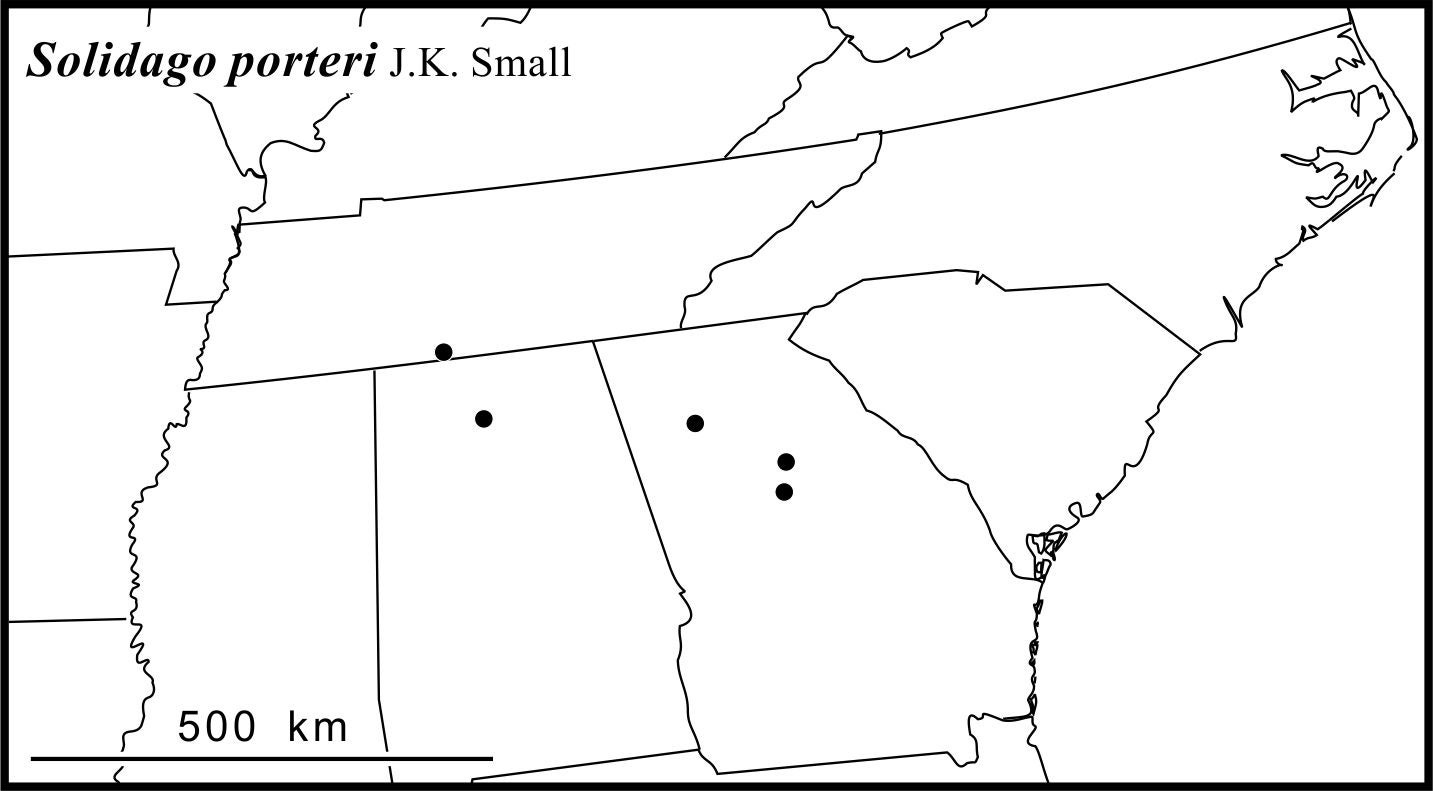Porter's Goldenrod
Solidago porteri Small is a very rare species native to Georgia, Alabama and Tennessee. Cronquist (1980) discussed the species under S. hispida noting it was only known from the type collection in Jasper Co., Georgia. Semple and Cook (2006 FNA) treated the species as a synonym of S. erecta based on stem pubescence traits. Semple and Estes (2014) reported the discovery of the species at one site in Tennessee and one (now extirpated) site in north central Alabama. They also noted the occurrence of a second site in Georgia slightly north of the original 1842 collection by Porter. Honeycutt et al. (2017) reported the discovery of another disjunct population in western Georgia. The species is distinguished within S. ser. Albigula by its combination of glabrate lower stems and sparsely hispid-strigose upper stems, stem leaves that are sparsely hispid-strigose on the under surface, and its large heads with showy rays. Like other members of sect. Erectae, the largest leaves are the petiolate lower stem leaves and the inflorescence arrays are elongated wand/club shaped.

The Alabama and Tennessee collections of the species were initially treated as S. petiolaris by both Semple and by Dwayne Estes, but ultimately recognized to be conspecific with the type specimens of S. porteri. Nesom annotated the Porter s.n. type material from Georgia as S. buckleyi and included it in his distribution map of that species and S. petiolaris (Nesom 1990). Semple and Gandhi (2012) noted the revised identification as S. porteri and presented a revised distribution of S. buckleyi. Both S. buckleyi and S. petiolaris are members of sect. Thyrsiflorae whose members lack large basal stem leaves and have usually glandular inflorescence parts.
The species is the only hexaploid (2n=54) in S. ser. Albigula (Raf.) Semple & J.B. Beck
Solidago porteri was included in a multivariate study of 14 species of S. subsect. Squarrosae (as delimited by Semple et al. 2017), in a multivariate study of the S. bicolor complex along with S. hispida, S. roanensis, and S. sciaphila and more broadly S. erecta (Semple et al. 2017), and in a study of S. georgiana, S. porteri, S. roanensis, S. squarrosa and S. villosicarpa (Semple et al. 2017). In all three studies, S. porteri was found to be one of the most distinct species in complex.
Honeycutt, E., T. Patrick, and J.C. Semple. 2017. Solidago porteri a goldenrod rediscovered. Tipularia 32: 44-48.
Semple, J.C. , and D. Estes. 2014. Discovery of Solidago porteri (Asteraceae: Astereae) in Alabama and Tennessee and a second population in Georgia. Phytoneuron 2014-45: 1–11.
Semple, J.C., L. Tong, and Y.A. Chong. 2017. Multivariate studies of Solidago subsect. Squarrosae. I. The Solidago speciosa complex (Asteraceae: Astereae). Phytoneuron 2017-18: 1–23.
Semple, J.C., L. Tong, Y. A. Chong and M. Kaddoura. 2017. Multivariate studies of Solidago subsect. Squarrosae. II. The Solidago bicolor –S. hispida complex (Asteraceae: Astereae). Phytoneuron 2017-33: 1–44.
Semple, J.C., L. Tong, and A. Chuong. 2017. Multivariate studies of Solidago subsect. Squarrosae. III. S. georgiana, S. porteri, S. roanensis, S. squarrosa and S. villosicarpa (Asteraceae: Astereae). Phytoneuron 2017-55: 1–17.
Last revised 19 May 2025 by J.C. Semple
© 2025 J.C. Semple, including all photographs unless otherwise indicated
1-6. Solidago porteri. 1. Habit, Semple 11867, Giles Co., Tennessee. 2. Lower-mid and upper stems, Semple 11190, Morgan Co., Alabama. 3. Adaxial leaf surfaces, S 11861. 4. Inflorescence, S 11861. 5. Heads, S 11861. 6. Fruit, Hill 1162a GA, Morgan Co., Georgia.











